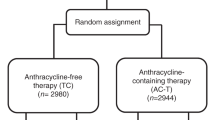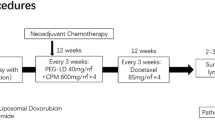Abstract
The prognosis of patients with stage IIIB breast carcinoma with tumour spread to the apical axillary lymph nodes has hardly improved despite adequate locoregional control and the introduction of systemic adjuvant therapy. A combined modality regimen that includes anthracyclin-based chemotherapy, high-dose chemotherapy with peripheral stem cell support and radiation and hormonal therapy is currently under investigation in this subset of patients. The present study aims to document the efficacy and feasibility of dose-intensive epidoxorubicin in combination with a standard dose of 5-fluorouracil and cyclophosphamide as up-front chemotherapy in this setting. A preoperative chemotherapy regimen consisting of three courses of 5-fluorouracil 500 mg m-2, epidoxorubicin 120 mg m-2 and cyclophosphamide 500 mg m-2 (FE120C) was administered at 21 day intervals without haematopoietic growth factors to 70 patients with apex node-positive disease. All patients were below 60 years of age and had not had prior chemotherapy or radiotherapy. Sixty-six patients were evaluable for clinical response and histopathological examination could be performed in 62 of these. Thirteen patients achieved a clinical complete response (20%). Of these patients, microscopic examination of the mastectomy specimen revealed absence of malignant cells in two and exclusively ductal carcinoma in situ (DCIS) in another two patients. In addition, of the 46 patients (70%) with a clinical partial response, at pathological examination one patient had sclerosis only and four had DCIS. This results in a pathological complete response in three (5%) of all patients and absence of invasive carcinoma in 10%. None of the patients progressed during chemotherapy. The major toxicity was moderate bone marrow suppression with a median white blood count (WBC) nadir of 1800 microliters-1 (range 500-4900). Other toxicities were mild. The full planned dose could be given without delays in 66 of 70 patients FE120C is well tolerated and is highly effective as up-front chemotherapy in relatively young patients with high-risk breast cancer, with a 90% (CI 74-98%) clinical objective response rate.
This is a preview of subscription content, access via your institution
Access options
Subscribe to this journal
Receive 24 print issues and online access
$259.00 per year
only $10.79 per issue
Buy this article
- Purchase on Springer Link
- Instant access to full article PDF
Prices may be subject to local taxes which are calculated during checkout
Similar content being viewed by others
Author information
Authors and Affiliations
Rights and permissions
About this article
Cite this article
van der Wall, E., Rutgers, E., Holtkamp, M. et al. Efficacy of up-front 5-fluorouracil – epidoxorubicin – cyclophosphamide (FEC) chemotherapy with an increased dose of epidoxorubicin in high-risk breast cancer patients. Br J Cancer 73, 1080–1085 (1996). https://doi.org/10.1038/bjc.1996.208
Issue Date:
DOI: https://doi.org/10.1038/bjc.1996.208
This article is cited by
-
Population analysis of the pharmacokinetics and the haematological toxicity of the fluorouracil-epirubicin-cyclophosphamide regimen in breast cancer patients
Cancer Chemotherapy and Pharmacology (2006)
-
Phase II study of a multi-course high-dose chemotherapy regimen incorporating cyclophosphamide, thiotepa, and carboplatin in stage IV breast cancer
Bone Marrow Transplantation (2001)



